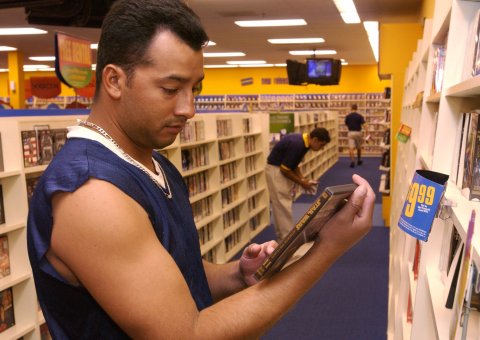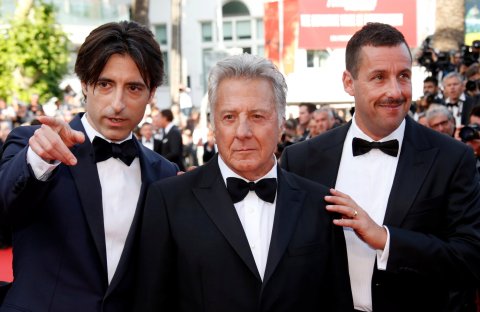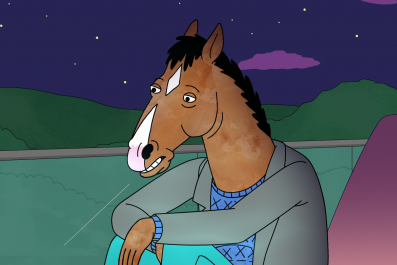Reed Hastings, the Netflix CEO who co-founded the company long before "streaming" entered the popular lexicon, was born during a fairly remarkable year for film. 1960 was the year Alfred Hitchcock's Psycho astounded and terrified audiences, influencing a half-century of horror to come. It was a year of outstanding comedies (Billy Wilder's The Apartment), outstanding epics (Stanley Kubrick's Spartacus) and outstandingly creepy thrillers (Michael Powell's Peeping Tom—a close cousin of Psycho).
But in the vast world of Netflix streaming, 1960 doesn't exist. There's one movie from 1961 available to watch (the original Parent Trap) and one selection from 1959 (Compulsion), but not a single film from 1960. It's like it never happened. There aren't any movies from 1963 either. Or 1968, 1955 or 1948. There are no Hitchcock films on Netflix. No classics from Sergio Leone or François Truffaut. When Debbie Reynolds died last Christmas week, grieving fans had to turn to Amazon Video for Singin' in the Rain and Susan Slept Here. You could fill a large film studies textbook with what's not available on Netflix.
Netflix's selection of classic cinema is abominable—and it seems to shrink more every year or so. As of this month, the streaming platform offers just 43 movies made before 1970, and fewer than 25 from the pre-1950 era (several of which are World War II documentaries). It's the sort of classics selection you'd expect to find in a decrepit video store in 1993, not on a leading entertainment platform that serves some 100 million global subscribers. Netflix's DVD subscribers enjoy a much wider selection (four million customers still opt to receive discs in the mail), but as the company shifts its focus to streaming and original content, cinephiles fear the cinematic canon is being left behind.
Related: The 21 best movies of 2016
"If you're the biggest name in film streaming services, the less you offer in classic movies, the more you imply that classic movies have less to offer," says Nora Fiore, a 26-year-old writer who has a blog devoted to classic cinema, "The Nitrate Diva." "It's a terrible message to put out there."
It wasn't always so bleak. Netflix, which just turned 20 years old, first expanded into streaming media in 2007. Back then, Fiore enjoyed the site's streaming offerings, when the service was still new and the movie selection more eclectic. (There was even a selection of Criterion Classics, which ended in 2011, when Criterion struck a deal with Hulu.) "I saw Breathless for the first time on Netflix," she says. "I saw Jules and Jim streaming on Netflix back in 2008 [or] 2009… They would also have some really weird movies that you got the feeling they bought with a package. Like, a movie I saw there for the first time that hardly anybody knows about is a movie called Specter of the Rose, a really weird poverty row film noir about a mad ballet dancer."
But in recent years, DVDs have started going the way of the floppy disk, and Netflix, the golden child of the streaming revolution, has started catering less to the film nerd and more to the average bored consumer. By 2013 or 2014, Fiore had canceled her subscription after noticing the classics selection had dropped off. She subscribes to other streaming services today, like Fandor and Warner Archive Instant, and holds tight to her large DVD collection.

Film professors and historians are particularly troubled by the situation.
"It was very distressing when Netflix began to phase out their huge inventory of movies available on DVD with the goal of shifting viewers over to the streaming model," says Stephen Prince, a cinema studies professor at Virginia Tech. "Now we see the danger inherent in this change—an emphasis on mainstream, contemporary movies has replaced what had been a broad archive of world cinema… Convenience biases viewers toward mainstream fare and makes films of the past or from other cultures less visible."
Gone are chains like Blockbuster or the quirky video rental stores that turned Quentin Tarantino into a film fanatic. "It's getting progressively harder to connect with non-contemporary film cultures outside hubs like L.A., where multiple venues offer gems for all ages," says Jan Olsson, the Swedish film scholar and author (most recently) of Hitchcock à la Carte. Olsson says access to film archives are essential in the streaming era. (The screenings in his classes at Stockholm University, for instance, are in 35 mm format.) "For educators outside schools close to film archives, this is a big problem. As DVDs are on the verge of being phased out, streams will be the key resource."
Prince has seen the shift away from classic cinema reflected in the classroom. "My students are heavily biased toward what's new and what can be streamed on portable devices," Prince says. "What isn't available to stream essentially doesn't exist. I've had students ask if it is okay to watch Vertigo on Youtube." (No.) Last year Prince taught a course on horror movies, during which he showed The Shining projected on a large screen. "One student who knew the film and had watched it on a laptop was astonished at how powerful it was when seen big."
Why are Netflix's classic offerings so lousy? "I believe their reading of the market and the vicissitudes of acquiring materials from the studio's film libraries are key factors," says Olsson. Translation: Streaming rights are expensive, and Netflix probably doesn't think the audience for old films is big enough to make it worthwhile. (A Netflix representative declined to comment on the record for this story.) The longer answer requires a deep dive into copyright law and the legal precedent of the first-sale doctrine, which made it easy for Netflix to rent out tangible media (DVDs) but does not apply to digital distribution.

"Studios never liked the idea that viewers might own copies of movies," Prince explains. "If I've purchased a DVD, I can do with it what I want—I can loan it out, resell it, give it away or even destroy it." That permitted Netflix to build an immense library of films without having to obtain the individual rights. With streaming, distribution rights are much thornier, as the writer and librarian Rachel Paige King explains here:
Streaming video is a service, services are subject to contract law, and contracts always supersede copyright law. [...] So, as the technology to disseminate all kinds of art and information becomes more sophisticated, so too does the means and the motive to restrict access. If entertainment industry executives are smart (and they are) they'll make sure that streaming video turns out to be a whole lot more expensive for consumers than home DVD rental.
The end result is a paltry, pathetic catalog of older films shackled by copyright law. It's a strange conundrum: The internet promises a century's worth of multimedia output at your fingertips but ruthlessly privileges whatever got released yesterday. Some films have been left behind in obsolete format hell. "There are some movies you basically have to break the law to see," says Fiore—for instance, the famously unavailable Joan Crawford flick Letty Lynton (1932).
I have many movies on DVD that are not available in any other way. What can be replaced by streaming is FAR from comprehensive.
— The Nitrate of the Hunter (@NitrateDiva) April 3, 2017
I'm sick of the assumption that everything worth watching is available. In fact, you may have to break the law to see certain great movies!
— The Nitrate of the Hunter (@NitrateDiva) April 3, 2017
You can find plenty of classic cinema on streaming if you know where to look. Amazon has a pretty robust streaming catalog, but the $2.99 (or more) price tag per rental makes it less attractive to the average consumer. (The Amazon Prime selection, free for Prime subscribers, is more limited in scope.) Then there is FilmStruck, a streaming service launched by Turner Classic Movies with the Criterion Collection in 2016. The selection is great—a curated mix of classic, foreign and hard-to-find movies—though it's geared toward the cinephile niche, which seems obvious but is worth emphasizing now that the market is so splintered.
"The gap between 'casual film fan' and 'film history buff' has never been harder—or more expensive—to bridge," Vox.com critic Todd VanDerWerff argued in a 2016 piece on the subject. VanDerWerff's conclusion: "It's never been easier to see classic movies—but it's never been harder to become obsessed with them."
When did interest in movies made before, say, 1980 become such a weirdo niche?
* * *
In early 2017, Netflix rolled out a clever new feature: Viewers could press a button and skip opening credits on TV shows. It made sense; when you're binging six episodes of Stranger Things in one afternoon, watching the same credits sequence over and over might get tiresome.
Then, this past May, Netflix expanded the feature, letting viewers skip past the title sequences of certain movies, as well. Cinephiles were horrified: These sequences often provide inventive opportunities for brilliant filmmakers, from the snowy desolation that opens Fargo to the chilling close-ups that suck you in at the beginning of Vertigo. Why would you skip that? "When we lose title sequences, we are losing something of artistic value," film critic Noah Gittell bemoaned in a Guardian piece.
For film buffs, this ill-advised option was more than a momentary stumble. It seemed indicative of a company that understands algorithms but not auteurs—a company detached from the cultural and curatorial knowledge commensurate with its enormous distributive power. In other words, Gittell wrote, it signified that Netflix "lacks reverence for cinema history." This was a minor misstep, but a major example of the increasing discomfort film buffs have with Netflix's dominance.
Netflix began on August 29, 1997, as a sort of mail-order Blockbuster, founded on the hunch that consumers were very sick of late fees. (Netflix's founding myth is that Hastings got the idea after paying Blockbuster a $40 late fee for a lost copy of Apollo 13, though this story is apparently a convenient fiction.) By 2007, Netflix had shipped more than a billion DVDs; the company was profitable and growing. But even then, Hastings had loftier ambitions. "Movies over the Internet are coming, and at some point it will become big business," he told an Inc.com interviewer in 2005. Netflix's goal, the soon-to-be billionaire added, was "[to become] a company like HBO that transforms the entertainment industry."
That goal has been achieved. The watershed moment was probably 2013, when Netflix's first piece of original programming, House of Cards, became a critical and commercial success. Cards whetted the appetite for more exclusive content. Orange Is the New Black—now with its fifth season available for streaming—followed that summer. Four years later, Netflix is spending $6 billion to add both original and licensed content in 2017, and like HBO, it has arguably become more synonymous with television these days than film. (When young people colloquially talk about "staying in and watching Netflix," they often mean binge-watching TV episodes, whether it's 30 Rock or a brand new show.) There's an entire cottage industry of digital media dedicated to tracking what's coming and going on Netflix every single month.
Once a digital library, the company now operates more like a deep-pocketed studio. The universal power of boredom guarantees that any piece of Netflix programming will be watched by millions simply by virtue of being plastered across the Netflix homepage. Consider the remarkably lucrative Adam Sandler deal. In March, the actor signed another four-movie deal with Netflix (which could cost the company $320 million or more). In April, Netflix revealed that its users had spent more than half a billion hours watching Sandler's movies. These movies made minimal cultural impact, but for the millions browsing Netflix.com for any damn new thing to watch, the marketing is unbeatable.

What gets left behind is the curation model of old. "Netflix's mission statement has changed," says the veteran film critic Leonard Maltin, now of LeonardMaltin.com. "Their focus is on original content. And they're no longer focused on serving their former customer base."
Maltin has experienced the frustration firsthand. After purchasing the book Opening Wednesday at a Theater Or Drive-In Near You: The Shadow Cinema of the American '70s recently, he was excited to learn that the UCLA film archive was hosting screenings in conjunction with it. "But I was out of town the night they were showing Prime Cut with Lee Marvin," Maltin says. "I said, I don't do this very often, but I'll stream it tonight when I get home. But I couldn't! It's not available for streaming!"
In a fit of desperation, he ordered the DVD. "As somebody for whom the classic era is a living, breathing thing," he adds, "it's distressing to me to have it dismissed this way." Fiore concurs. "I think it's so important that classic film and new movies or series exist side by side," she says. "How cool would it be to be able to watch Netflix's new Marvel series, which are so infused with film noir, and then explore the films that influenced them on the same platform?"
Meanwhile, friction between Netflix and segments of the film community spiked into outright hostility in mid-2017. In May came the opening-credits scuffle. That same month, at Cannes, the sight of the Netflix logo drew boos from cranky festival attendees during a screening of Bong Joon Ho's inventive Okja, one of two Netflix films entered into festival competition (the other being Noah Baumbach's The Meyerowitz Stories). Critics and judges grumbled because the films weren't getting a proper theatrical release. "Cries of protest from French film-industry executives prompted Thierry Frémaux, the festival director, to declare that, in future, only films guaranteed a theatrical release in France can qualify for the top Palme d'Or prize," The Economist reported. Jury president Pedro Almodóvar also signalled his distaste for the streaming-only model, and Christopher Nolan, a big-screen disciple, derided Netflix's model as "pointless" in an interview the following month. Nolan vowed never to work with the company because of its "bizarre aversion" to the theatrical experience.
There are plenty of Netflix advocates, particularly among indie filmmakers and producers who see it as a viable alternative to traditional Hollywood. The model can be a godsend for funding or distributing unorthodox projects. To The Bone, the recent anorexia drama, is a fine example. So is Okja. The quirky and critically acclaimed satire, hailed as the streaming platform's first great original film, wasn't cheap to produce. "I don't think anyone would have made this if it weren't for Netflix," the movie's screenwriter, Jon Ronson, told Newsweek in May. He couldn't imagine a traditional studio funding it.
The Okja model might be integral for the independent films of the future, but does it have to come at the expense of the past? Perhaps someday classic cinema will find a new renaissance in the streaming sector. But Maltin isn't taking any chances.
"Frankly, this is why I'm keeping all my DVDs," he says. "And it's a pain in the neck, because they take up space. But I don't trust the cloud. And I don't trust the marketplace to maintain titles that are in some cases obscure or not terribly commercial."
This article has been updated to reflect that FilmStruck was launched with the Criterion Collection.














